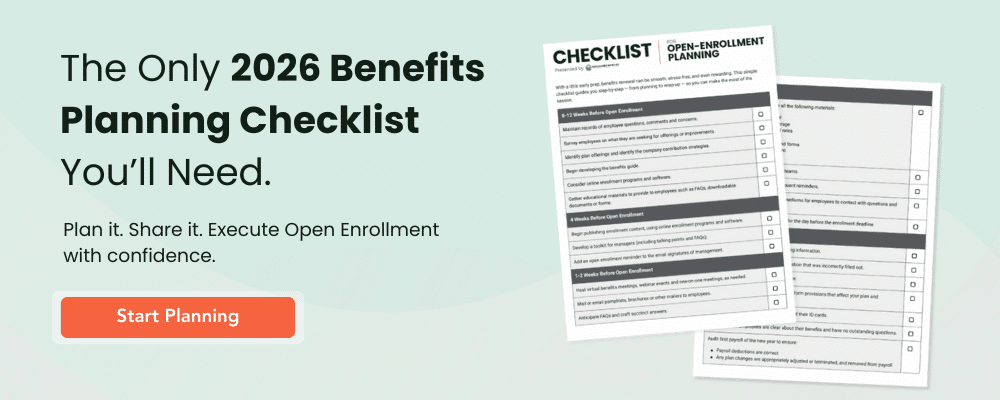
Employers expect 2026 health insurance costs to rise at the fastest pace in 15 years. Industry analysts project a 12.1% average increase for small-group plans, one of the steepest hikes since the Affordable Care Act took effect.
For many business leaders, that creates tough decisions: absorb the cost, pass more on to employees, or reduce coverage. The good news is that with early planning and smart strategy, you can manage rising premiums and keep your benefits competitive.
What’s Driving Premium Increases
When evaluating health coverage for your company, it’s helpful to understand why premiums increase in the first place.
Key factors include:
- Medical inflation and hospital costs – Higher wages for healthcare staff, pricier supplies, and post-pandemic backlogs drive provider charges.
- Specialty drug growth – Effective but expensive treatments for chronic and rare diseases continue to push claims higher.
- Pent-up demand for care – Deferred checkups and elective procedures are catching up.
- Uptick in mental health services as employers expand access and reduce stigma.
- An aging workforce – Older populations typically generate higher average claims.
None of these trends are likely to reverse soon, which means the solution lies in plan design, funding methods, and how you help employees use their benefits wisely.
Four Proven Strategies to Manage Rising Premiums
Start Renewal Planning Early
The single most effective way to control health insurance costs is to give yourself enough runway. Waiting until a few weeks before renewal almost guarantees limited choices and little negotiating power. Instead, begin evaluating your plan 90–120 days before your renewal date.
Why early matters
- Carriers release renewal rates well in advance. Starting early lets you compare multiple quotes instead of scrambling to accept the first one you receive.
- Brokers and PEO partners can explore alternative funding methods, like level-funded or partially self-funded plans, which require more lead time to set up.
- Your finance team can model different contribution levels and assess the impact on budgets and cash flow.
Steps to take early in the process
- Review utilization data: Look at claims reports to see which benefits employees use most, which services go largely unused, and where high-cost claims originate. This helps you make targeted changes—like adjusting coinsurance or adding telehealth—without broad cuts.
- Compare carriers and plan designs: Even small adjustments such as higher deductibles paired with employer-funded HSAs, or shifting from a PPO to an HSA-compatible plan, can lower premiums significantly.
- Ask about multi-year guarantees or rate caps: Some carriers will lock in rates or cap increases for two or three years, giving your budget predictable guardrails.
- Coordinate employee feedback: Distribute a short, anonymous survey to capture pain points—like network limitations or confusion about mental health benefits—so changes are aligned with employee needs.
- Communicate early and often: Early preparation also gives you time to communicate clearly with employees. You can explain why changes are happening, outline cost-saving steps like telehealth usage, and ensure everyone understands enrollment deadlines. Transparent communication reduces anxiety and helps employees see that you are making thoughtful decisions.
Starting well before renewal doesn’t just buy time; it also ensures a smooth transition. It creates leverage with carriers, space for creative plan design, and confidence that your team will be informed and ready for any changes.

Consider a Professional Employer Organization (PEO)
For many small and midsize businesses, a Professional Employer Organization (PEO) can completely change the economics of offering health insurance. A PEO acts as a co-employer—you continue to run your company day to day, but the PEO becomes the “employer of record” for HR, payroll, and benefits administration.
This structure lets many small companies band together as one large group when negotiating with insurance carriers. That bigger pool of employees delivers buying power that most small businesses can’t match on their own.
Key advantages of partnering with a PEO
- Access to large-group rates and plan designs
PEOs negotiate at the scale of a mid-sized or even large company, which means lower premiums and access to richer plan options, including national provider networks and comprehensive mental health or telehealth benefits.
- Simplified HR and payroll administration
A PEO can take on payroll processing, tax filings, ACA reporting, and compliance tasks that normally consume hours each week. This frees up time for strategic work and reduces the risk of costly errors.
- Built-in compliance expertise
From Affordable Care Act requirements to state-specific employment laws, PEOs stay on top of ever-changing regulations so you don’t have to. They can help you stay compliant and avoid penalties.
- A wider menu of employee benefits
Beyond health insurance, many PEOs give you the option to offer perks that feel “Fortune 500” such as dental and vision coverage, disability insurance, life insurance, employee assistance programs (EAPs), commuter benefits, or lifestyle perks like discounted gym memberships.
Financial impact
Often, the combined savings on health insurance and HR efficiencies more than offset the PEO service fees. Many employers find that the improved plan quality also helps with employee retention and recruiting, which carries its own long-term financial value.
When a PEO is a strong fit
- Companies with 10 – 200 employees that are growing quickly or adding remote staff in multiple states
- Employers struggling with year-over-year double-digit premium increases
- Teams that lack in-house HR resources but still want to offer competitive benefits
The best next step is to compare PEO proposals alongside traditional plans during renewal planning. This ensures you understand both the financial savings and the service-level benefits before making a decision.
Make preventive care the norm
Even the best health plan will see premiums rise if employees use care in costly or inefficient ways. Encouraging smarter care habits can directly reduce claims and future premium increases while supporting your team’s well-being.
- Highlight services that are 100% covered under most plans, such as annual physicals, age-appropriate screenings, and routine vaccinations.
- Remind employees that preventive care isn’t just for detecting illness—it’s an opportunity to build long-term relationships with providers and catch issues early, when treatment is less expensive.
- Consider offering small incentives, such as gift cards or wellness points, to reward participation in annual check-ups or screenings.
Normalize telehealth and virtual visits
- Educate staff on when a telehealth or virtual mental health visit is the right first step.
- Point out that these visits are typically a fraction of the cost of urgent care or ER trips and can often be scheduled the same day.
- Provide simple “how to” resources—logins, app links, and typical copays—so employees feel confident choosing telehealth.
Provide clear cost-navigation tools
- Share easy-to-access in-network provider directories and remind employees that out-of-network visits can be dramatically more expensive.
- Offer cost-comparison tools or apps that allow employees to check the price of lab tests, imaging, or outpatient procedures before scheduling.
- Encourage conversations with primary care doctors about the most cost-effective options for routine or chronic care.
Invest in wellness and chronic-condition management
- Support programs for chronic conditions like diabetes, hypertension, and asthma, which drive a large portion of total claims.
- Promote stress management, fitness challenges, or smoking cessation programs that address the root causes of long-term health costs.
- If your plan includes free or discounted digital coaching or health-tracking tools, make sure employees know how to use them.
Why it matters
A workforce that understands and uses these benefits wisely not only stays healthier but also generates fewer high-cost claims. This can stabilize or even reduce premiums over time. Plus, employees who feel supported in their health and wellness are more engaged and productive.
Promoting preventive and cost-conscious care isn’t a one-time memo—it’s an ongoing communication strategy that pays dividends for both employees and the company.
Explore Alternative Funding Arrangements
Traditional fully insured health plans aren’t your only option. Depending on your company’s size, claims history, and appetite for risk, exploring different funding structures can provide greater flexibility and potential cost savings than a standard premium-based plan.
Level-Funded Plans
- How it works: You pay a fixed monthly amount that combines estimated claims funding, administrative fees, and stop-loss insurance (which protects you from unexpectedly high claims).
- Why it helps: If your team’s actual claims come in lower than projected, your business may receive a year-end refund or credit. That creates an incentive for healthy behaviors and careful plan use.
- Good fit for: Employers with around 20–100 employees and a relatively healthy workforce looking for predictable monthly costs but willing to share in any upside from lower claims.
Partially Self-Funded Plans
- How it works: You pay employees’ medical claims directly up to a certain limit while carrying stop-loss coverage to cap your financial exposure.
- Why it helps: By taking on more of the risk yourself, you avoid some of the insurer’s built-in profit and risk charges, which can result in significant savings if your claims stay stable.
- Good fit for: Larger small businesses (often 75+ employees) with steady claims history, strong cash flow, and a desire to customize benefits more fully.
Other creative options to discuss with your broker or PEO
- Captive arrangements: A group of employers pools resources and shares risk collectively, gaining negotiating power and potential dividends.
- Reference-based pricing models: Ties payments to a multiple of Medicare rates rather than provider-billed charges, which can lower costs for certain services.
What to keep in mind
- These plans require careful financial analysis and a knowledgeable advisor to model costs, understand regulatory requirements (like ERISA and ACA compliance), and ensure stop-loss coverage is adequate.
- Robust claims reporting and employee education are essential to avoid surprises and maintain cost control.
- Switching funding models typically works best as part of a 12–18 month benefits strategy, not a last-minute renewal decision.
When executed thoughtfully, alternative funding arrangements can help employers gain more control over costs, reward a healthy workforce, and smooth out premium spikes over time—all while maintaining strong coverage for employees.
Turning Rising Costs into an Opportunity
A premium hike can feel like a setback, but it can also spark smarter benefits planning. By starting renewals early, evaluating plan design with real data, partnering with a PEO, promoting preventive care, and considering alternative funding, you can turn a challenge into a competitive advantage.
Next Steps at a Glance
- Pull claims data and review plan performance
- Set a 90–120 day renewal calendar
- Compare carriers or PEOs, plan designs, and funding models
- Build an employee communication and education plan
The bottom line: Health insurance premiums are rising sharply in 2026, but small businesses aren’t powerless. With proactive planning and the right HR partner, you can keep costs manageable and support your team’s well-being.